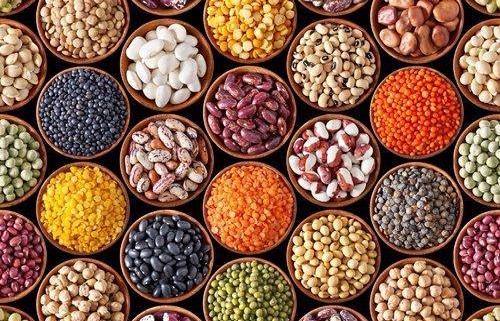Beans are among the oldest cultivated plants …
In fact, fossil records demonstrate that prehistoric people domesticated and cultivated legumes for food. Today, this extremely large category of vegetables contains over 13,000 species and is second only to grains in supplying calories and protein to the world’s population. Compared to grains, legumes supply about the same number of total calories but usually provide 2-to-4 times as much protein.
Legumes are often called “the poor people’s meat,” however, they might be better known as the “healthy people’s meat.” Many legumes, especially adzuki, mung, and garbanzo, are demonstrating impressive health benefits. Diets rich in legumes are being used to lower cholesterol levels, improve blood glucose control in diabetics, and reduce the risk of many cancers. Legumes contain many important nutrients and phytochemicals, and when combined with grains, they form a complete protein. According to studies conducted by the United States Department of Agriculture, richly colored dried beans offer a high degree of antioxidant protection. In fact, small red adzuki and mung beans rated the highest just ahead of blueberries.
Beans are a very inexpensive form of good protein and the are the most popular food source among the healthiest cultures. I just bought enough beans, lentils, quinoa and buckwheat for myself, my son, daughter-in-law, and granddaughter for our trip to Costa Rica. I spent $60, including a bottle of Bragg Amino Acid, which will last us for the ten days. Compare that to meat at $10.00 a pound. I can’t emphasize enough how important beans and grains are together. They build your body with important nutritional value, proteins, enzymes, minerals, vitamins and fiber that cut your risk of heart disease, cancer, diabetes and obesity by 70%, where meat and dairy will increase your chances of all those diseases by 70%. Don’t overlook the fact that beans and grains are a healthy way to maintain your weight.
The major health benefit of beans is their rich source of cholesterol-lowering fiber. In addition to lowering cholesterol, the high fiber content of beans prevents blood sugar levels from rising too rapidly after a meal, making these beans an especially good choice for individuals with diabetes, insulin resistance, or hypoglycemia.
Beans’ contribution to heart health lies not just in their fiber but in the significant amounts of antioxidants, folic acid, vitamin B6, and magnesium these beans supply. Folic acid and B6 help lower levels of homocysteine, an amino acid that is an intermediate product in an important metabolic process called the methylation cycle. Elevated blood levels of homocysteine are an independent risk factor for heart attack, stroke, or peripheral vascular disease, and are found in between 20-to-40 percent of patients with heart disease.
Intake of beans is also protective against cancer. In one analysis of dietary data collected by validated food frequency questionnaires in 1991 and 1995 from 90,630 women in the Nurses Health Study II researchers found a significantly reduced frequency of breast cancer in those women who consumed a higher intake of beans or lentils. That was not surprising, what was surprising was that only beans and lentils seemed to offer protection. Intake of tea, onions, apples, string beans, broccoli, green pepper, or blueberries did not have the same beneficial protection. Eating beans or lentils two or more times per week was associated with a 24% reduced risk of breast cancer.
I eat beans most
Of my life. I cook them with buckwheat, quinoa, hulled barley and wheat berries. I also sprout them and mix them with my salads. There are a lot of different kinds of beans and they are all very nutritional. I just like mung, adzuki, and garbanzo so I stick with those three beans. I also eat lentils like red, green and French dark green. The lentils are easy to cook with buckwheat and quinoa. The dry beans can be cooked with hulled barley and wheat berries as they take about an hour to simmer. If you want to cut the time down and cook them with buckwheat, just soak them overnight.
To sprout the beans, soak them overnight, rinse them thoroughly and put them in a sprouting jar with a screen lid. Just rinse them really well in the jar and make sure to get all the water out. Place the beans in a darker part of your kitchen for three days, rinsing them twice a day until they sprout…..make sure to refrigerate after the sprout. I mix them with my salads….thank you veganurth for the info

 no
no
 no
no